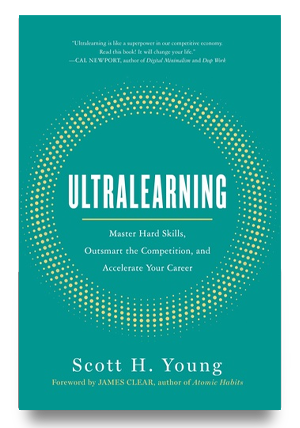I often get asked whether I’ll do another big learning project, like the MIT Challenge or Year Without English. The truth is I don’t know. Choosing projects—especially ones which will last many months and require intense effort—isn’t something I take lightly.
Making a good choice about which projects to pursue can make a huge difference. A good project doesn’t just advance your ambitions, in a rational, calculating way. It also inspires you, and has the ability to switch your mindset from one of checking off the daily chores to fevered excitement, where you’re more worried about working yourself too hard than too little.
A bad choice can have equally disastrous consequences. It can tie up your time for years. It can feel like slogging through mud, struggling to wake up in the morning. I suspect bad projects have also been the cause of more than their fare share of existential crises.
With all that pressure, it can be hard to make a decision. In this article, I’d like to outline my strategy for choosing projects. It’s been the process I’ve used for my learning projects like the MIT Challenge and Year Without English. It’s also been the process I’ve used for business projects like Top Performer or starting this blog.
Step One: Gather Interesting Ideas
The first phase of choosing a project comes from cultivating interesting ideas. These aren’t ready to be acted upon yet. Often they contain a fatal flaw that would prevent them from being realistic projects. Other times they could work, in principle, but they’re not compelling enough yet.
I gather lots of ideas. Here’s some of the ideas that I’m currently incubating:
- Go through a publisher and write a book about rapid self-education.
- Learn cognitive science a la MIT Challenge via UC San Diego’s reading list.
- Business expansion. Build new a portfolio of courses/info products.
- Learn art. Paint every day, perhaps with the end goal of selling paintings/recognition?
- Language level-up. Go back and take examinations to reach advanced/fluent levels in current intermediate languages.
- Career learning challenge. Try to build a freelancing business from scratch, in a new skill, in a short period of time.
Most of these will never become projects. That’s okay. Ideas are cheap, while actually completing long projects is very hard.
Step Two: Incubate Those Ideas
The most successful projects I did, usually didn’t start out as perfect ideas. There were often major problems with the ideas that made them somewhat less compelling. I try to regularly revisit project ideas I’ve had and think through some of their difficulties. Incubated over a long enough period of time, some can actually go from being interesting notions to compelling ideas I’m entirely certain I want to devote months and years of my life towards them.
This evolution of ideas is often hard to see from the outside, so it can appear as if the fully grown product appeared spontaneously, out of nowhere. Here was the original idea evolution for the Year Without English, for example:
- Both Vat and I decide we want to travel. He’s about to do his masters, so has a convenient reason to quit his job.
- Some suggestions are thrown out. Road trip around North America? Spend a month in Korea?
- A friend of ours embarks on a 9-month round-the-world tour. We both agree, seeing multiple different parts of the world, side-by-side would make for a good trip.
- We discuss and decide that going for a year, around the world, will probably be exhausting if we change locations too much. Maybe we’ll only go to 3-6 countries.
- I realize doing the trip has a possible implication for blogging about learning languages. Vat also seems interested.
- We decide to go to four countries, to learn four different languages. Now it’s getting more interesting.
- If it’s going to be a blogging project, it needs to have a bit of a hook. We’re both unsure of how good we’ll actually be at learning languages in a short time (I’ve only done French before, and it took over a year to get so-so at it), so claiming to reach fluency is unrealistic. We knew we would be learning through immersion anyways, so the idea of not speaking English at all comes up as a possible hook.
- By now we’ve been doing some minimal prep learning the languages, researching locations, preparing visas, etc. We start to talk about how travel has the opportunity to be more interesting for doing videos than learning computer science was.
- The idea of doing small mini-documentaries evolves, as we decide to not only learn the languages but try to show our progress as richly as possible.
This evolution took place over around a year. It consisted of many conversations as the idea went from road trip to multilingual odyssey.
Two important factors are worth noting here:
- The initial idea may be interesting, but not enough that you feel compelled to marshal immense resources towards it. If the underlying idea is good though, that desire can be built as the idea is refined.
- The incubation process takes a long time. The MIT Challenge had a similar incubation length, starting from the notion of doing some computer science classes in my spare time to attempting an entire degree’s final exams and projects.
Step Three: Uncover Flaws in Your Ideas
No idea will be perfect. There will always be naysayers and people who think it’s a bad idea. That’s to be expected and you shouldn’t wait until you’ve removed all possible doubt before starting an idea.
Despite this, however, it’s very important to try to figure out what the flaws in your ideas are before you embark on a long project. As you uncover those flaws, often you can work around them or fix them before things get too developed.
If an idea has a big flaw I can’t resolve, I often put it back into the idea pile, to periodically revisit. Sometimes, upon further reflection, the flaw is less serious than I had previously imagined and I move ahead despite it being unresolved. Other times, I recognize an alternative route that can bypass the problem I’ve uncovered.
The biggest types of flaws I try to reveal are ones where there is a conflict between my infatuation with the project idea and it’s reasonableness as a tool to help meet my broader goals and ambitions.
I’m not against pursuing things simply because they won’t grow my business or increase my income. I think pursuing projects because you love them is a great reason to pursue them. I would have gladly done the MIT Challenge even if nobody else thought it was interesting.
But I do have a few worries when picking projects with unclear benefits:
- If you don’t feel you have a stake in the project, the idea may inspire you, but it’s far more likely to be forgotten or abandoned when “real” things come up. The best way to motivate yourself for a project is to believe it isn’t frivolous, that it is a potential game-changer for your bigger goals.
- There are so many potential projects that can harmonize both with your ambitions and passions, that choosing projects which don’t fit a broader purpose is often just lazy thinking.
- If a project is clearly not going to advance my ambitions, that’s probably better than one that does so in a very hard-to-justify way. That’s because hobby projects can stay hobbies, whereas career projects will tend to demand more resources than they deserve, especially if their actual benefit to your career is minimal. I say it’s better to start a project knowing it’s just for a hobby.
Step Four: Commit to the Project
The decision to commit to the project is easy, provided you’ve adequately done the previous three steps. If you’ve generated lots of ideas to choose from, incubated those ideas for months or years and then sought out and tried to resolve any flaws in the project, chances are you’ll be left with ideas that are extremely compelling.
Those ideas beg to be realized. It’s easy to commit to ideas once they’ve crossed this threshold because you’ve been thinking about them in increasing detail for months and months.
Choosing Differently
This process of selecting projects isn’t the one I’ve seen advocated most frequently. Instead, I’ve heard a lot more people that focus on quickly starting projects and blindly rushing into things without worrying about getting paralyzed by analysis.
Those worries are real. I do find that this process can sometimes be frustrating if no ideas are currently at the threshold of compellingness to trigger a commitment. It can also be easy to summarily reject ideas because they contained a single flaw. Good ideas start with many flaws, and it requires a lot of thinking to see if they can be resolved or safely ignored.
If you do follow this process, however, I think it’s possible to generate projects that truly inspire you. Ideas that you’re willing to throw every bit of your effort at for months or even years. I also believe it’s those kinds of projects that result in meaningful accomplishments, because you’re able to operate at such a higher level of effectiveness when in that state of total commitment and drive.


 I'm a Wall Street Journal bestselling author, podcast host, computer programmer and an avid reader. Since 2006, I've published weekly essays on this website to help people like you learn and think better. My work has been featured in The New York Times, BBC, TEDx, Pocket, Business Insider and more. I don't promise I have all the answers, just a place to start.
I'm a Wall Street Journal bestselling author, podcast host, computer programmer and an avid reader. Since 2006, I've published weekly essays on this website to help people like you learn and think better. My work has been featured in The New York Times, BBC, TEDx, Pocket, Business Insider and more. I don't promise I have all the answers, just a place to start.